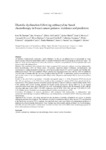Mostrar o rexistro simple do ítem
Diastolic dysfunction following anthracycline-based chemotherapy in breast cancer patients: incidence and predictors
| dc.contributor.author | Serrano, José M. | |
| dc.contributor.author | González, Iria | |
| dc.contributor.author | Castillo, Silvia del | |
| dc.contributor.author | Muñiz, Javier | |
| dc.contributor.author | Morales, Luis J. | |
| dc.contributor.author | Moreno, Fernando | |
| dc.contributor.author | Jiménez, Rosa | |
| dc.contributor.author | Cristóbal, Carmen | |
| dc.contributor.author | Graupner, Catherine | |
| dc.contributor.author | Talavera, Pedro | |
| dc.contributor.author | Curcio, Alejandro | |
| dc.contributor.author | Martínez, Paula | |
| dc.contributor.author | Guerra, Juan A. | |
| dc.contributor.author | Alonso, Joaquin J | |
| dc.date.accessioned | 2016-10-28T10:24:52Z | |
| dc.date.available | 2016-10-28T10:24:52Z | |
| dc.date.issued | 2015-07-16 | |
| dc.identifier.citation | Serrano JM, González I, Castillo S, et al. Diastolic dysfunction following anthracycline-based chemotherapy in breast cancer patients: incidence and predictors. Oncologist. 2015; 20(8):864-72 | es_ES |
| dc.identifier.uri | http://hdl.handle.net/2183/17503 | |
| dc.description.abstract | [Abstract] INTRODUCTION: Cardiotoxicity represents a major limitation for the use of anthracyclines or trastuzumab in breast cancer patients. Data from longitudinal studies of diastolic dysfunction (DD) in this group of patients are scarce. The objective of the present study was to assess the incidence, evolution, and predictors of DD in patients with breast cancer treated with anthracyclines. METHODS: This analytical, observational cohort study comprised 100 consecutive patients receiving anthracycline-based chemotherapy (CHT) for breast cancer. All patients underwent clinical evaluation, echocardiogram, and measurement of cardiac biomarkers at baseline, end of anthracycline-based CHT, and at 3 months and 9 months after anthracycline-based CHT was completed. Fifteen patients receiving trastuzumab were followed with two additional visits at 6 and 12 months after the last dose of anthracycline-based CHT. A multivariate analysis was performed to find variables related to the development of DD. Fifteen of the 100 patients had baseline DD and were excluded from this analysis. RESULTS: At the end of follow-up (median: 12 months, interquartile range: 11.1-12.8), 49 patients (57.6%) developed DD. DD was persistent in 36 (73%) but reversible in the remaining 13 patients (27%). Four patients developed cardiotoxicity (three patients had left ventricular systolic dysfunction and one suffered a sudden cardiac death). None of the patients with normal diastolic function developed systolic dysfunction during follow-up. In the logistic regression model, body mass index (BMI) and age were independently related to the development of DD, with the following odds ratio values: BMI: 1.19 (95% confidence interval [CI]: 1.04-1.36), and age: 1.12 (95% CI: 1.03-1.19). Neither cardiac biomarkers nor remaining clinical variables were predictors of DD. CONCLUSION: Development of diastolic dysfunction after treatment with anthracycline or anthracycline- plus trastuzumab chemotherapy is common. BMI and age were independently associated with DD following anthracycline chemotherapy. | es_ES |
| dc.description.sponsorship | Instituto de Salud Carlos III; RD06/0014/002 | es_ES |
| dc.description.sponsorship | Instituto de Salud Carlos III; RD12/0042/0067 | es_ES |
| dc.language.iso | eng | es_ES |
| dc.publisher | AlphaMed Press | es_ES |
| dc.relation.uri | http://dx.doi.org/10.1634/theoncologist.2014-0500 | es_ES |
| dc.subject | Anthracycline chemotherapy | es_ES |
| dc.subject | Breast cancer | es_ES |
| dc.subject | Cardiac biomarkers | es_ES |
| dc.subject | Diastolic dysfunction | es_ES |
| dc.title | Diastolic dysfunction following anthracycline-based chemotherapy in breast cancer patients: incidence and predictors | es_ES |
| dc.type | info:eu-repo/semantics/article | es_ES |
| dc.rights.access | info:eu-repo/semantics/openAccess | es_ES |
| UDC.journalTitle | The Oncologist | es_ES |
| UDC.volume | 20 | es_ES |
| UDC.issue | 8 | es_ES |
| UDC.startPage | 864 | es_ES |
| UDC.endPage | 872 | es_ES |
Ficheiros no ítem
Este ítem aparece na(s) seguinte(s) colección(s)
-
INIBIC-ECAPE - Artigos [31]
-
GI- GRINCAR - Artigos [219]






